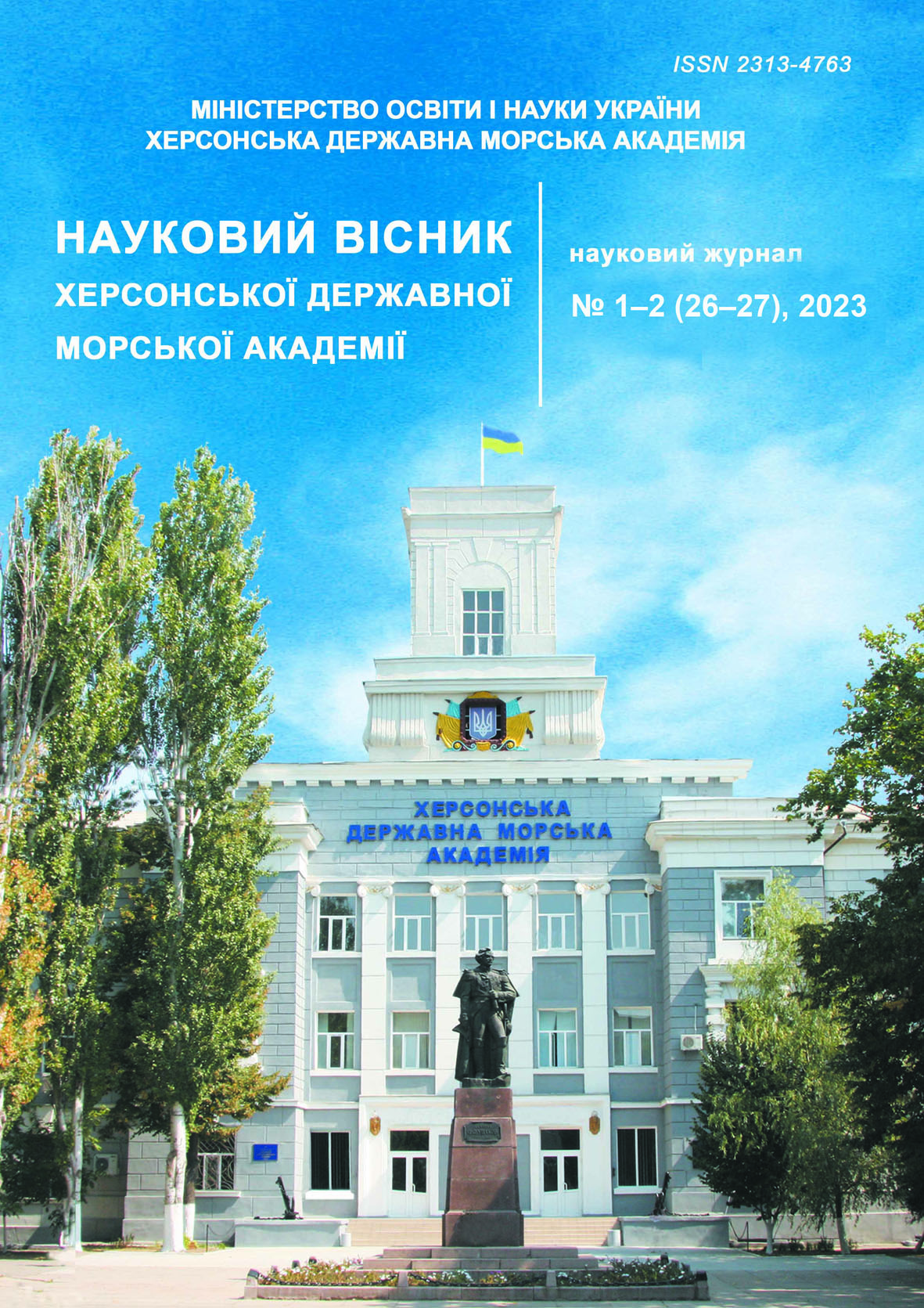AUTOMATIC CONTROL OF THE VESSEL IN A STORM
https://doi.org/10.33815/2313-4763.2023.1-2.26-27.120-132
Abstract
Adverse weather and sea conditions are the most difficult sailing conditions on the route. Long rolling, need for constant concentration of attention greatly exhausts the crew and leads to wrong decisions. Existing methods of storming are not very effective, as they have low accuracy, significant time delays between obtaining data for calculation and determining safe movement parameters, lack of possibility of constant determination of safe movement parameters, difficulty in identifying the dominant factor from the system of dangerous factors, intuitive assessment of the level of danger. The purpose of the research is to develop a method of automatic storming that will ensure safe sailing in storms. The method, algorithmic and software of the automatic ship control module in the storm have been developed, which allows forming safe and optimal parameters of the ship's movement. The obtained results are explained by the use of an on-board computer, solving, at each step of the on-board computer, an optimization problem with nonlinear constraints. The use of nonlinear constraints allows to optimize the objective function taking into account the dangers of stormy sailing: synchronous and parametric resonance, loss of stability in following seas, impact of group waves in the stern of the ship, exceeding permissible loads on the structure of the ship's hull, etc. The obtained results differ from known solutions in that for the first time the problem of automatic optimal control of ship in a storm is solved, which allows to significantly reduce the influence of human factor on storm processes and increase the safety of shipping. The results obtained are reproducible and scalable. Extensibility is explained by taking into account other hazards in the form of restrictions on optimization parameters. The theoretical significance of the obtained results lies in the application of the nonlinear optimization method with linear and nonlinear constraints of the type of inequalities to find optimal and safe storm parameters. The practical significance of the obtained results lies in the possibility of applying the developed methods in automatic ship control module in a storm, which allows to reduce the influence of human factor on storming processes, reduce fatigue of the crew, and increase the safety of navigation.
References
2. Vahushchenko, L. L., Vahushchenko, A. L., Zaichko, S. I. (2005). Bortovi avtomatyzovani systemy kontroliu morekhidnosti. Odesa: Feniks, 272 s.
3. Remez, Yu. V. Kachka korablia,. L. (1983).: Sudnobuduvannia, 328 s.
4. Capt. Takuzo Okada. (2019). Marine Weather Ship Handling in Rough Sea, Japan P&I Club. P&I Loss Prevention Bulletin 45, 108 p.
5. Qianfeng Jing, Kenji Sasa, Chen Chen, Yong Yin, Hironori Yasukawa, Daisuke Terada. (2021). Analysis of ship maneuvering difficulties under severe weather based on onboard measurements and realistic simulation of ocean environment. Ocean Engineering. Volume 221, Article 108524 ISSN 0029-8018, https://doi.org/10.1016/j.oceaneng.2020.108524.
6. Ershov, A., Buklis, P. (2018). Ways to increase speed and economy of tanker fuel during storm navigation. Bulletin of the State Maritime and River Fleet University named after Admiral S. O. Makarov 10 (6), pp. 1122–1131, doi: 10.21821/2309-5180-2018-10-6-1122-1131.
7. France, W., Levadou, M., Treakle, T., Paulling, J., Michel, R., Moore, C. (2003). An investigation of head-sea parametric rolling and its influence on container lashing systems, Marine Technology 40(1), pp. 1–19. doi: 10.5957/mt1.2003.40.1.1.
8. Eremenko, A., Zhukov, Y. (2016). Smart onboard seafaring safety assurance system, Electrical and computer systems 22(98), pp. 293–300.
9. Zinchenko, S., Tovstokoryi, O., Mateichuk, V., Nosov, P., Popovych, I., Gritsuk, I. (2022). Automatic vessel steering in a storm. Electrical, Control and Communication Engineering. 2022, vol. 18, no. 1, pp. 66–74, https://doi.org/10.2478/ecce-2022-0009.
10. Mateichuk, V., Zinchenko, S., Tovstokoryi, O., Nosov, P., Nahrybelnyi, Ya, Popovych, I. and Kobets, V. (2021). Automatic Vessel Control in Stormy Conditions. 2-nd International workshop on computational & Information Technologies for Control & Modeling (CITCM 2021), 5 November. Rivne, Ukraine.
11. Mateichuk, V. M., Zinchenko, S. M., Nosov, P. S., Mamenko, P. P., Kyrychenko, K. V. (2022). Avtomatychne shtormuvannia iz vrakhuvanniam naiavnoho dempfuvannia. Materialy II Mizhnarodnoi naukovo – praktychnoi konferentsii "Problemy staloho rozvytku morskoi haluzi", Kherson.
12. Parametric Roll Assessment. (2019). Rule Note NR 667 DT R00 E. Bureau Veritas. 92937 Paris La Défense Cedex – France.
13. Guide for the assessment of parametric roll resonance in the design of container carriers. (2019). American Bureau of Shipping Incorporated by Act of Legislature of the State of New York, 1862.
14. New DNV anti-roll app helps avoid container losshttps://www.dnv.com/expert-story/maritime-impact/New-DNV-anti-roll-app-helps-avoid-container-loss.html#article-lightbox1.
15. International Maritime Organization, “Revised guidance to the master for avoiding dangerous situations in adverse weather and sea conditions,” IMO MSC.1/Circ.1228, 2007. Available: https://www.liscr.com/revised-guidance-master-avoiding-dangeroussituations-adverse-weather-and-sea-conditions.
16. Katsutoshi Takeda, Masanori Akagi, Kinya Ishibashi. (2023). Introduction of “Guidelines on Preventive Measures againts Parametric Rolling”. ClassNK Technical Journal №7.
17. Bonci, M. (2019). The manoeuvrability of high-speed craft in the following sea. https://doi.org/10.4233/uuid:843b41a4-fb9f-4211-8280-5767a03146eb.
18. Zinchenko, S., Mateichuk, V., Nosov, P., Popovych, I., Solovey, O., Mamenko, P., Grosheva, O. (2020). Use of Simulator Equipment for the Development and Testing of Vessel Control Systems / Electrical, Control and Communication Engineering. – 2020. – Vol.16. – №2. – P.58–64. DOI: 10.2478/ecce-2020-0009. https://sciendo.com/pdf/10.2478/ecce-2020-0009.


